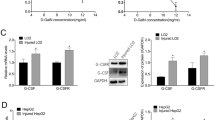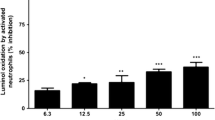Abstract
Introduction
Apoptosis is a central mechanism of cell death following reperfusion of the ischemic liver. Recombinant human erythropoietin (rhEPO) have an important role in the treatment of myocardial ischemia/reperfusion (I/R) injury, by preventing apoptosis. The aim of the study was to investigate the effect of different regimens of rhEPO in preventing apoptosis following I/R-induced hepatic injury.
Material and methods
Isolated mouse livers were randomly divided into five groups: (1) control group, perfused for the whole study period (105 min); (2) 30-min perfusion followed by 90 min of ischemia and 15 min of reperfusion; (3), (4) and (5) like group 2, but with administration of rhEPO 5,000 units/kg i.p. at 30 min, 24 h, or both 30 min and 24 h respectively, before induction of ischemia. Perfusate liver enzyme levels and intrahepatic caspase-3 activity were measured, and apoptotic cells were identified by morphological criteria, TUNEL assay, and immunohistochemistry for caspase-3. Using immunoblot the expression of the proapoptotic JNK and inhibitor of NFκB (IκBα) were also evaluated. von Willebrand factor (vWF) immunohistochemistry was used as a marker of endothelial cells.
Results
Compared to the I/R livers, all 3 rhEPO pretreated groups showed: a significant reduction in liver enzyme levels (P < 0.05) and intrahepatic caspase-3 activity (P < 0.05), fewer apoptotic hepatocytes (P < 0.05) and positive vWF staining in numerous endothelial cells lining the sinusoids. EPO decreased JNK phosphorylation and the degradation of the inhibitor of NFκB (IκBα) during I/R. There was no added benefit of the multiple- over the single-dose rhEPO regimen.
Conclusion
Pretreatment with one dose of rhEPO can attenuate post-I/R hepatocyte apoptotic liver damage. NFκB and JNK activation is likely to play a pivotal role in the pathophysiology of I/R hepatic injury and might have a key role in EPO-mediated protective effects. This effect is associated with the increase in sinusoidal vWF immunostaining suggests an additional effect of rhEPO in liver angiogenesis recovery. These findings have important implications for the potential use of rhEPO in I/R injury during liver transplantation.







Similar content being viewed by others

References
Clavien PA, Harvey PR, Strasberg SM (1992) Preservation and reperfusion injuries in liver allografts. An overview and synthesis of current studies. Transplantation 53:957–978
Jaeschke H (1996) Preservation injury: mechanisms, prevention and consequences. J Hepatol 25:774–780
Jaeschke H, Lemasters JJ (2003) Apoptosis versus oncotic necrosis in hepatic ischemia/reperfusion injury. Gastroenterology 125:1246–1257
Rudiger HA, Graf R, Clavien PA (2003) Liver ischemia: apoptosis as a central mechanism of injury. J Invest Surg 16:149–159
Georgiev P, Dahm F, Graf R, Clavien PA (2006) Blocking the path to death: anti-apoptotic molecules in ischemica/reperfusion injury of the liver. Curr Pharm Des 12(23):2911–2921
Uehara T, Bennett B, Sakata ST, Satoh Y, Bilter GK, Westwick JK, Brenner DA (2005) JNK mediates hepatic ischemia reperfusion injury. J Hepatol 42:850–859
Lewis LD (2004) Preclinical and clinical studies: A preview of potential future applications of erythropoietic agents. Semin Hematol 41(suppl 7):217–225
Liu X, Xie W, Liu P, Duan M, Jia Z, Li W, Xu J (2006) Mechanism of cardioprotection of rhEPO pretreatment on suppressing the inflammatory response in ischemia-reperfusion. Life Sci 78:2255–2264
Bogoyevitch MA (2004) An update on the cardiac effects of erythropoietin cardioprotection by erythropoietin and the lessons learnt from studies in neuroprotection. Cradiovasc Res 63:208–216
Yang CW, Li C, Jung JY, Shin SJ, Choi BS, Lim SW et al (2003) Preconditioning with erythropoietin protects against subsequent ischemia-reperfusion injury in rat kidney. FASEB J 17(12):1754–1755
Calvillo L, Latini R, Kajstura J, Leri A, Anversa P, Ghezzi P et al (2003) Recombinant human erythropoietin protects the myocardium from ischemia-reperfusion injury and promotes beneficial remodeling. Proc Natl Acad Sci 100(8):4802–4806
Chong ZZ, Kang JQ, Maiese K (2002) Hematopoietic factor erythropoietin fosters neuroprotection through novel signal transduction cascades. J Cereb Blood Flow Metab 22(5):503–514
Sakanaka M, Wen TC, Matsuda S, Masuda S, Morishita E, Nagao M, Sasaki R (1998) In vivo evidence that erythropoietin protects neurons from ischemic damage. Proc Natl Acad Sci U S A 95(8):4635–4640
Weinbroum A, Nielsen VG, Tan S, Gelman S, Matalon S, Skinner KA et al (1995) Liver ischemia-reperfusion increases pulmonary permeability in rat: role of circulating xanthine oxidase. Am J Physiol 266:G998–G996
Ravid A, Koren R, Rotem C, Garach-Jehoshua O, Glaser T, Liberman UA (1994) 1,25-Dihydroxyvitamin D3 increases the cellular content of the calcium-activated neutral protease mu-calpain in renal cell carcinoma. Endocrinology 135:2822–2825
Siren AL, Fratelli M, Brines M, Goemans C, Casagrande S, Lewczuk P, Keenan S, Gleiter C, Pasquali C, Capobianco A, Mennini T, Heumann R, Cerami A, Ehrenreich H, Ghezzi P (2001) Erythropoietin prevents neuronal apoptosis after cerebral ischemia and metabolic stress. Proc Natl Acad Sci U S A 98(7):4044–4049
Sepodes B, Maio R, Pinto R, Sharples E, Oliveira P, McDonald M et al (2006) Recombinant human erythropoietin protects the liver from hepatic ischemia-reperfusion injury in the rat. Transpl Int 19(11):919–926
Schmeding M, Neumann UP, Boas-Knoop S, Spinelli A, Neuhaus P (2007) Erythropoietin reduces ischemia-reperfusion injury in the rat liver. Eur Surg Res 39(3):189–197
Bendinelli P, Piccoletti R, Maroni P, Bernelli-Zazzera A (1996) The MAP kinase cascades are activated during post-ischemic liver reperfusion. FEBS Lett 398:193–197
Bradham CA, Stachlewitz RF, Gao W, Qian T, Jayadev S, Jenkins G et al (1997) Reperfusion after liver transplantation in rats differentially activates the mitogen-activated protein kinases. Hepatology 25:1128–1135
Crenesse D, Gugenheim J, Hornoy J, Tornieri K, Laurens M, Cambien B et al (2000) Protein kinase activation by warm and cold hypoxia-reoxygenation in primary-cultured rat hepatocytes JNK(1)/SAPK(1) involvement in apoptosis. Hepatology 32:1029–1036
Fan C, Yang J, Engelhardt JF (2002) Temporal pattern of NfkappaB activation influences apoptotic cell fate in a stimuli-dependent fashion. J Cell Sci 115:4843–4853
Luedde T, Assmus U, Wustefeld T et al (2005) Deletion of IKK2 in hepatocytes does not sensitize these cells to TNF-induced apoptosis but protects from ischemia/reperfusion injury. J Clin Invest 115:849–859
Fan C, Li Q, Zhang Y et al (2004) IkappaB alpha and Ikappa B beta possess injury context-specific functions that uniquely influence hepatic NF-kappaB induction and inflammation. J Clin Invest 113:746–755
Luedde T, Trautwein C (2006) Intracellular survival pathways in the liver. Liver Int 26(10):1163–1174
Spandou E, Tsouchnikas I, Karkavelas G, Dounousi E, Simeonidou C, Guiba-Tziampiri O, Tsakiris D (2006) Erythropoietin attenuates renal injury in experimental acute renal failure ischaemic/reperfusion model. Nephrol Dial Transplant 21(2):330–336
Natori S, Selzner M, Valentino KL, Fritz LC, Srinivasan A, Clavien PA, Gores GJ (1999) Apoptosis of sinusoidal endothelial cells occurs during liver preservation injury by a caspase-dependent mechanism. Transplantation 68(1):89–96
Huet PM, Nagaoka MR, Desbiens G, Tarrab E, Brault A, Bralet MP, Bilodeau M (2004) Sinusoidal endothelial cell and hepatocyte death following cold ischemia-warm reperfusion of the rat liver. Hepatology 39(4):1110–1119
Anagnostou A, Lee ES, Kessimian N, Levinson R, Steiner M (1990) Erythropoietin has a mitogenic and positive chemotactic effect on endothelial cells. Proc Natl Acad Sci USA 87(15):5978–5982
Anagnostou A, Liu Z, Steiner M, Chin K, Lee ES, Kessimian N, Noguchi CT (1994) Erythropoietin receptor mRNA expression in human endothelial cells. Proc Natl Acad Sci USA 91(9):3974–3978
LeCouter J, Moritz DR, Li B, Phillips GL, Liang XH, Gerber HP, Hillan KJ, Ferrara N (2003) Angiogenesis-independent endothelial protection of liver: role of VEGFR-1. Science 299(5608):890–893
Terayama N, Terada T, Nakanuma Y (1996) An immunohistochemical study of tumour vessels in metastatic liver cancers and the surrounding liver tissue. Histopathology 29:37–43
Urashima S, Tsutsumi M, Nakase K, Wang JS, Takada A (1993) Studies on capillarization of the hepatic sinusoids in alcoholic liver disease. Alcohol Suppl 1B:77–84
Hattori M, Fukuda Y, Imoto M, Koyama Y, Nakano I, Urano F (1991) Histochemical properties of vascular and sinusoidal endothelial cells in liver diseases. Gastroenterol Jpn 26:336–343
Baruch Y, Neubauer K, Shenkar L, Sabo E, Ritzel A, Wilfling T, Ramadori G (2002) von Willebrand factor in plasma and in liver tissue after partial hepatectomy in the rat. J Hepatol 37(4):471–477
Moon C, Krawczyk M, Lakatta EG, Talan MI (2006) Therapeutic effectiveness of a single vs multiple doses of erythropoietin after experimental myocardial infarction in rats. Cardiovasc Drugs Ther 20(4):245–251
Author information
Authors and Affiliations
Corresponding author
Additional information
Edith Hochhauser and Orit Pappo are first two coauthors.
Rights and permissions
About this article
Cite this article
Hochhauser, E., Pappo, O., Ribakovsky, E. et al. Recombinant human erythropoietin attenuates hepatic injury induced by ischemia/reperfusion in an isolated mouse liver model. Apoptosis 13, 77–86 (2008). https://doi.org/10.1007/s10495-007-0155-8
Published:
Issue Date:
DOI: https://doi.org/10.1007/s10495-007-0155-8



